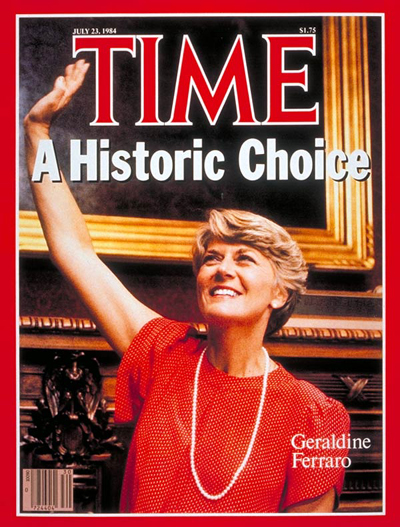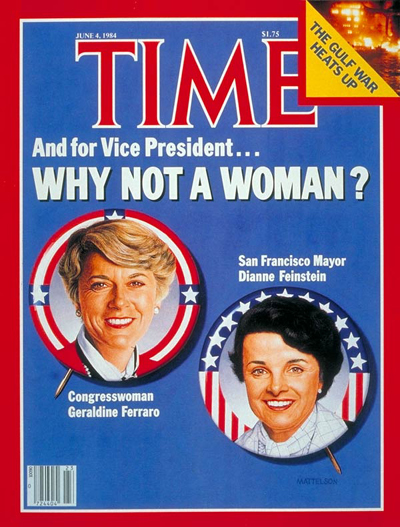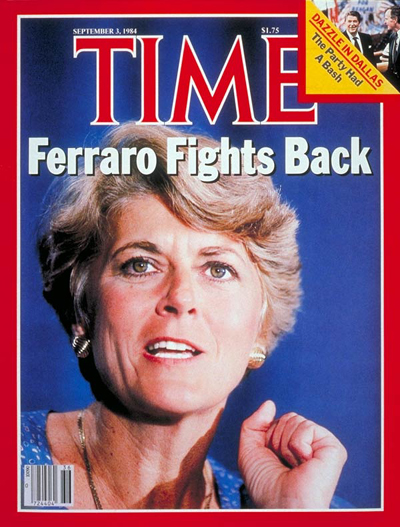
By accepting the nomination to be Joe Biden’s Democratic Vice Presidential nominee on Aug. 19, Kamala Harris became the third woman —as well as the first Black woman and the first person of Indian descent — to be selected as a running mate on a major presidential party ticket.
She follows in the footsteps of Geraldine Ferraro, who became the first woman on a major White House ticket when she was picked to be the running mate of 1984 Democratic presidential candidate Walter Mondale. (Sarah Palin, a Republican, was second.)
In a July 23, 1984, cover story headlined “A Historic Choice,” TIME reported that Democratic presidential candidate Walter Mondale picked a woman in order to liven up the ticket. (In fact, Ferraro wasn’t the only woman he considered; TIME reported that then-San Francisco Mayor Dianne Feinstein was en route to a studio for a TIME photo shoot when Mondale called her to say he had chosen someone else.)
The magazine argued that choosing Ferraro, who was also the first Italian-American vice presidential candidate for a major party, was also practical on some level. It could woo women—who represent a majority of the electorate—as well as “ethnic” and “urban” voters, the story read. The choice “transformed” what had become a “dull” campaign by adding “verve” and “flair.” It also energized a women’s movement recently disappointed by the lapsed deadline to ratify the Equal Rights Amendment in 1982.

No matter what it would mean to the ticket, Ferraro knew what it meant to women across the country.
“We always have anxieties until we do it the first time, and then we usually recognize that those anxieties are baseless,” she said, responding to polls indicating resistance to a female vice presidential candidate among Southern white men. “This is a first, and it’s bound to create concerns; but we are going to put those concerns to rest quickly.”
Speaking more broadly about the broader significance of her candidacy on society, she said, “If a woman can be Vice President of the U.S., what job is there that a woman cannot do?”
The magazine further described the significance of the choice back then in that issue:
History. So this is how it’s made. One tends to think of history making in terms of treaties, crownings, facts, but it’s the mind that makes the changes. Come November, a woman from Tulsa (Hartford, Butte) will hear the curtain of the voting booth shut behind her, and she will be alone with America and her own life. Another woman’s name will be on the ballot before her. However she votes, her thoughts about her place in the world will not be the same again…
Feminism has scored no more spectacular triumph since women won the right to vote. Even with universal suffrage, American women had enjoyed, until last Thursday, nothing more than the right to elect a man to the White House. With one swift stroke, however, the Democrats have made it possible for women to enter the final phase of their enfranchisement. Win or lose in November, Geraldine Ferraro is now emblematic of the truest, purest facet of the American dream: that every citizen is entitled to an equal chance…
As Dr. Carol Nadelson, the Incoming President of the American Psychiatric Association, pointed out, male children will learn the new rules too. “A fifth-grade boy,” she says, “also has a view of a woman as being in a kind of role. This change expands his view of women.”…
The high-pitched hopefulness coursed through every social realm, not just that of national politics. “Any time a woman reaches a revered status, it is easier for the secretary in an office to have a better sense of her self-worth,” said Faye Wattleton, President of Planned Parenthood. “That secretary may not want to be President of the U.S., but she may want to be president of her company.”
Ferraro was born in Newburgh, N.Y., on Aug. 26, 1935, (now known as Women’s Equality Day) in the middle of the Great Depression. Her father died when she was young, and her mother, a seamstress, raised the family in the South Bronx. After college, Ferraro taught second grade in the 1950s, but got bored and started attending Fordham Law School at night. After graduation, however, she found that Wall Street law firms were still resistant to hiring women, and she became a stay-at-home parent—until her cousin, who was Queens District Attorney, hired her as a prosecutor. When she wasn’t handling child abuse, rape and domestic violence cases, she was involved in local Democratic politics and talking to voters.
In 1978, she ran for Congress, to represent the neighborhood in Queens, N.Y., known for being home to Archie Bunker. She won. True to her campaign slogan, “Finally, A Tough Democrat,” she became known for not seeking out the cameras and her behind-the-scenes deal-making skills.
Get your history fix in one place: sign up for the weekly TIME History newsletter

The excitement about Democratic vice presidential nominee Ferraro was short-lived, however. By August, a controversy over her husband’s reluctance to release his tax returns raised eyebrows, and the couple ended up paying $53,000 to the IRS for a so-called accounting error. Her lack of foreign policy experience also made her vulnerable to attacks, especially in the middle of the Cold War.
In the end, America re-elected President Reagan in a landslide. Catholics, women and Italian Americans voted for him over Mondale by large margins, leaving TIME to conclude in the Nov. 19, 1984, issue that Ferraro “appears to have hurt Mondale at the polls more than she helped him.” A woman in Memphis told TIME, “I’m a liberated woman, but I don’t think a woman should be running things in Washington.”
After the election, Ferraro returned to practicing law, accepted a fellowship at Harvard, wrote books and served as U.S. ambassador to the United Nations Commission on Human Rights. She also made unsuccessful bids for the U.S. Senate.
Today, Ferraro, who died in 2011 at the age of 75, is remembered less for the elections she lost, and more for the elections that her 1984 vice presidential candidacy helped other women win.
“Gerry and I are often linked together,” Secretary of State and future presidential nominee Hillary Rodham Clinton said at Ferraro’s funeral. “She is seen correctly as paving the way for my political career and those of many other women. We owe her so much. She inspired us women and girls. All of us thought new thoughts and imagined new possibilities because of Gerry.”
At the time, Mondale also recalled the resistance she faced from men on the 1984 campaign trail.
“We went down to Mississippi, and some old farmer said, ‘Young lady, do you make good blueberry muffins?’ And she said, ‘Yes. Do you?’ That was the kind of thing that she was bumping up against,” he told TIME. “She had to keep her cool. She had to be nice about it. And yet she was undergoing a revolution. It wasn’t just automatic. It was her guts and her vision and the depth of her beliefs that helped her get it done.”
More Must-Reads from TIME
- Donald Trump Is TIME's 2024 Person of the Year
- Why We Chose Trump as Person of the Year
- Is Intermittent Fasting Good or Bad for You?
- The 100 Must-Read Books of 2024
- The 20 Best Christmas TV Episodes
- Column: If Optimism Feels Ridiculous Now, Try Hope
- The Future of Climate Action Is Trade Policy
- Merle Bombardieri Is Helping People Make the Baby Decision
Write to Olivia B. Waxman at olivia.waxman@time.com